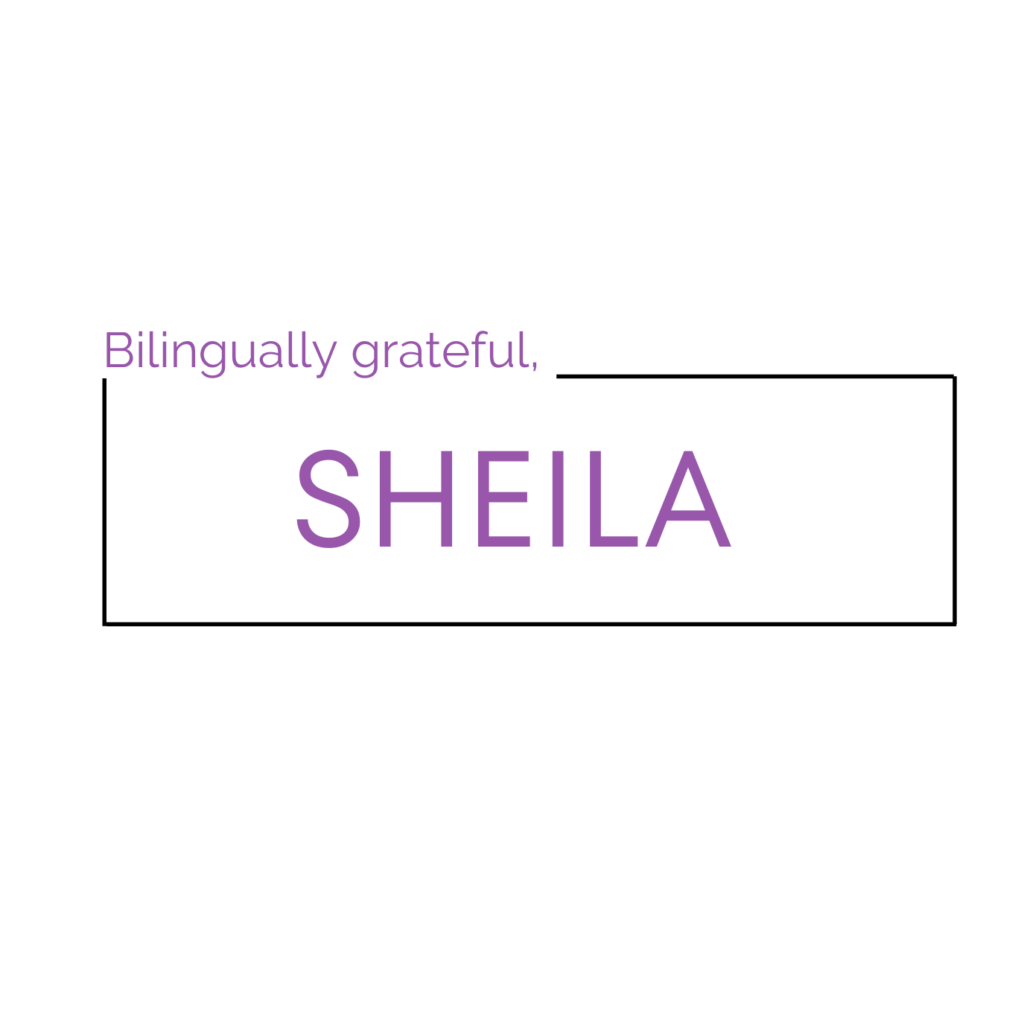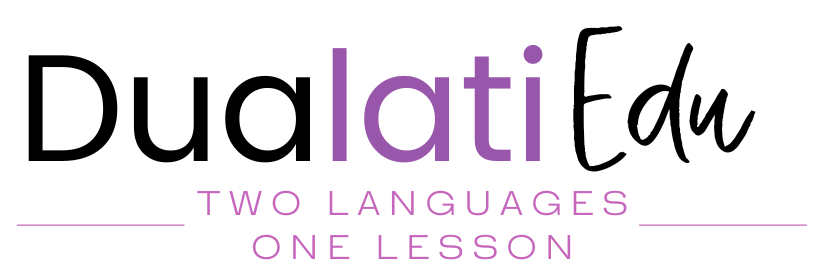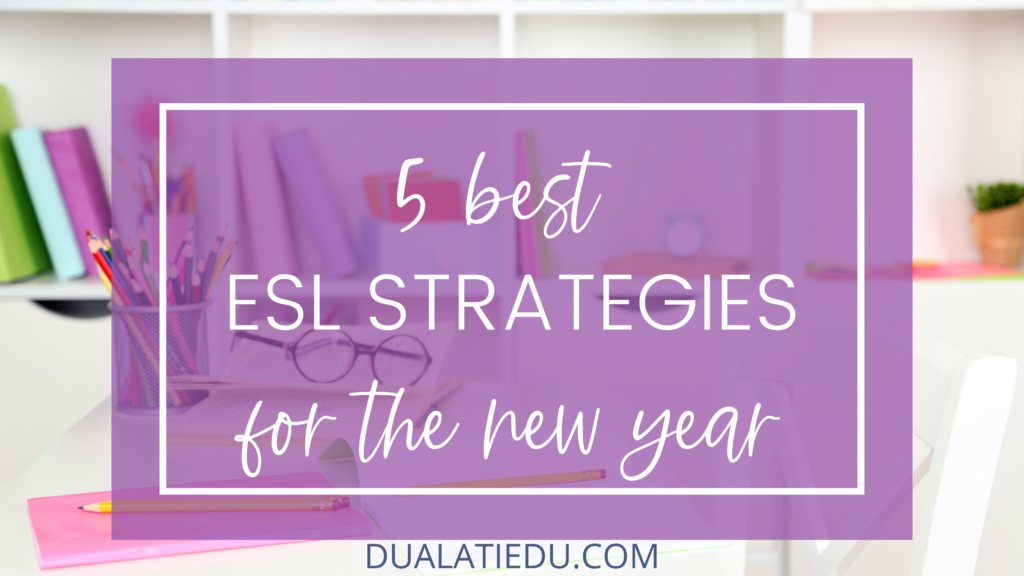You have a bachelor’s degree in education, check! You also have an ESL supplemental certification. But, somehow, reaching English learners is still a struggle. Guess what? You are not alone. So, you are here looking for the best ESL strategies to use in your classroom.
Providing instruction in English to a diverse population of English learners can be daunting. It’s understandable. English learners have many different backgrounds and native languages. The US Dept. of Education reports that English learners in US schools speak over 400 languages.
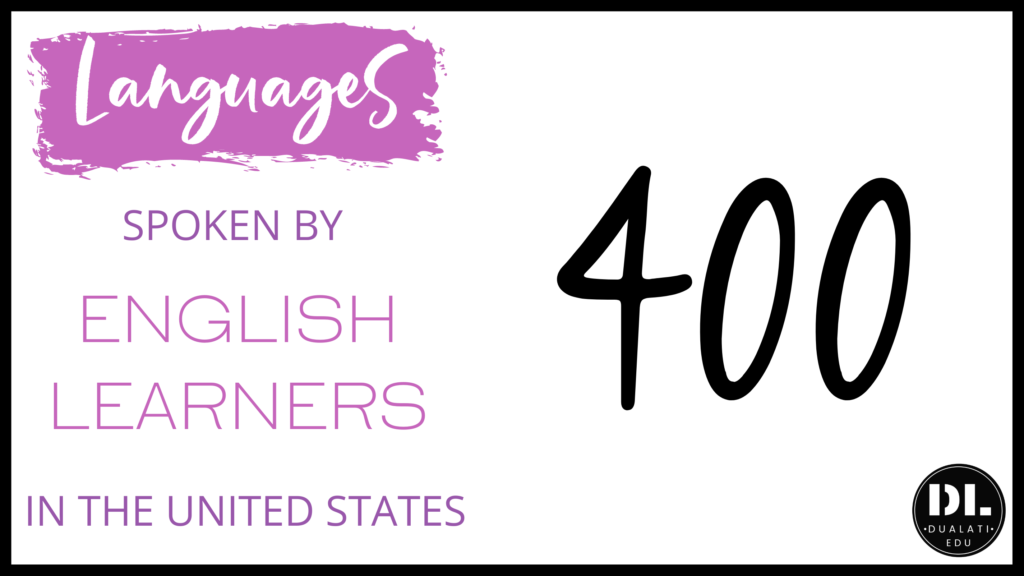
So, how can teachers make sure that students feel comfortable enough to communicate with their teachers and peers? How can teachers make content accessible for students to engage in authentic learning activities? How can teachers spend less time planning?
Teachers need a detailed, multi-approach plan. Language acquisition standards are available to teachers. However, the resources and training on ESL strategies in the classroom needs to be more readily available and part of the yearly professional development of all teachers.
We should understand that one specific ESL plan doesn’t meet everyone’s needs or expectations. Teacher programs give you the knowledge to build a plan that would suit teacher’s strengths and student’s needs. However, placing this task on a new year teacher is overwhelming. Everyone knows that teachers struggle their first year in the classroom.
So, what are the specific struggles?
Struggles ESL teachers encounter in the classroom
As a bilingual teacher, coach, and administrator, I have asked colleagues what they struggle with the most when teaching English learners. Here is a list of their answers:
1 . Grade-appropriate English acquisition training and resources
2. Differentiation of subject content in English
3. Assessment of learning of content in English
4. Reporting grades for differentiated instruction
Now, as an ESL teacher, what can you do to make sure your students learn English, grade-level content while you don’t spend countless extra hours of research, planning, and wondering what to do?
Best ESL strategies
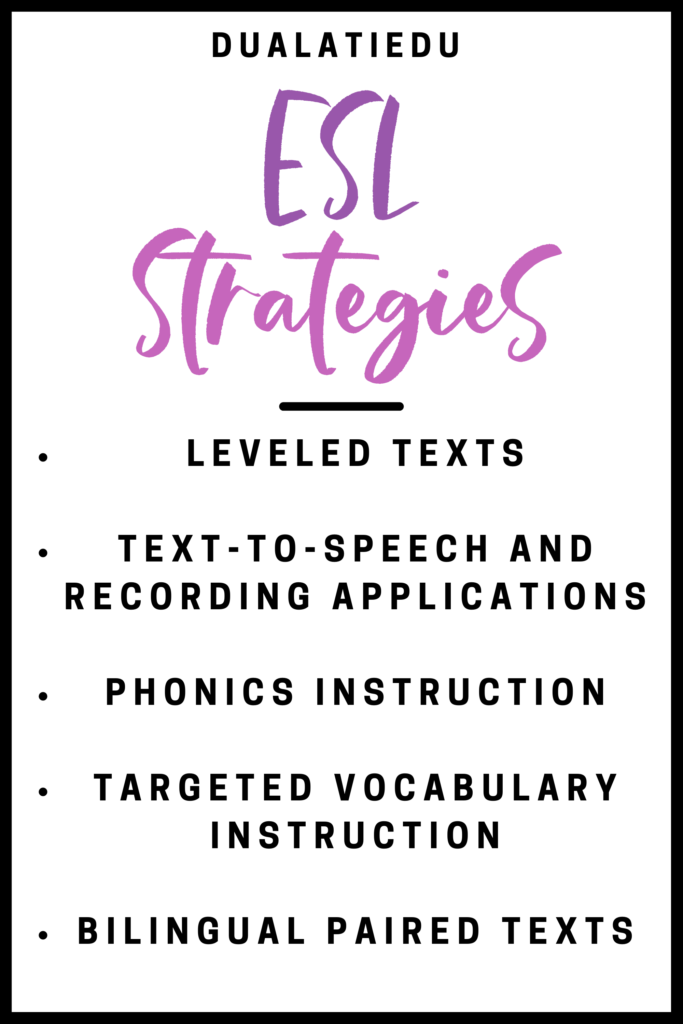
ESL Strategy #1 – Leveled Texts
Leveled texts are a teacher’s best tool to differentiate instruction! Why? It provides instruction on the focus standards and provides EL students with text similar to what the rest of your students have. Having the same texts as others boosts students’ confidence because they feel like part of the classroom.
Look for leveled texts in your basal adoption first! If you are unsure the basal brings leveled readers, ask your instructional coach at your campus or district.
If your campus has a literacy library, you could search there! Ask your librarian or literacy coach.
You can also look for leveled texts online. These are a few websites that I have found helpful.
TweenTribune (Spanish texts available)
Reading A to Z (Spanish texts available)
COMMONLIT (Spanish texts available)
ESL Strategy #2 -Text-to-Speech and Recording applications
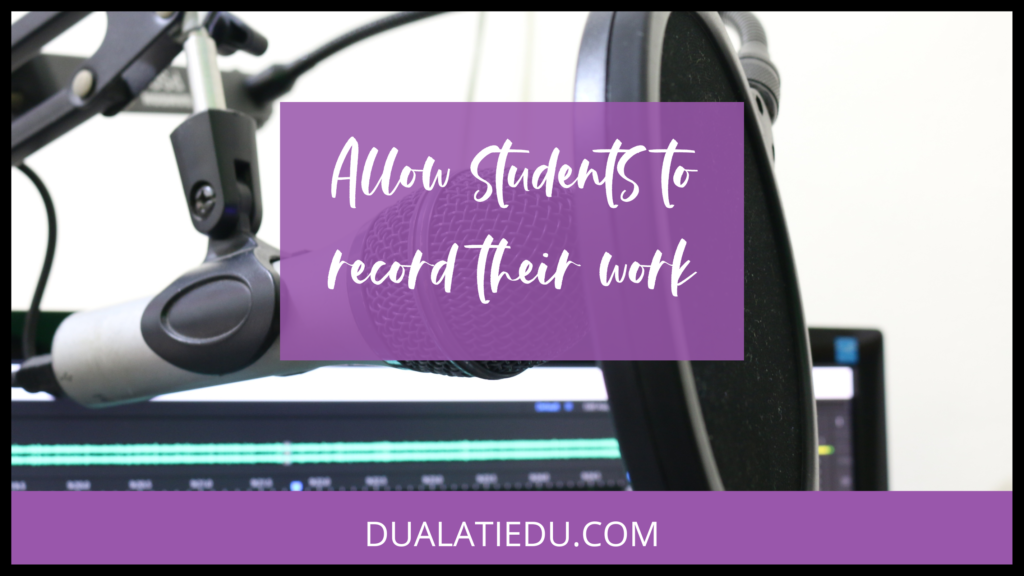
Text-to-speech
Reading a text may be more difficult for some English learners, so having the text read aloud is an excellent way to scaffold instruction. Teachers also can use this tool for any struggling reader.
Having the text read aloud models fluency and prosody, allows students to become familiar with sight words, and provides the opportunity for English learners to hear correct pronunciation privately.
It allows for students to lower that affective filter and confidently read text aloud to others or answer comprehension questions.
These types of apps abound in this digital age, so speak with your school or district technology specialist to help you decide which would suit your needs the best while following your district cybersecurity and digital citizenship guidelines.
Audio/Video Recording
Most ESL strategies focus on reading or writing. However, we can agree that most want to be to communicate with their peers. So, focusing on developing the ability to speak in English is crucial.
Have students practice reading aloud or allow students to answer orally instead writing out answers.
It provides a way for them confidently read text aloud for the teacher or classmates to hear. They can also answer comprehension questions orally in a private setting.
Seesaw and Fliprgrid are popular choices.
ESL Strategy #3
Phonics Instruction
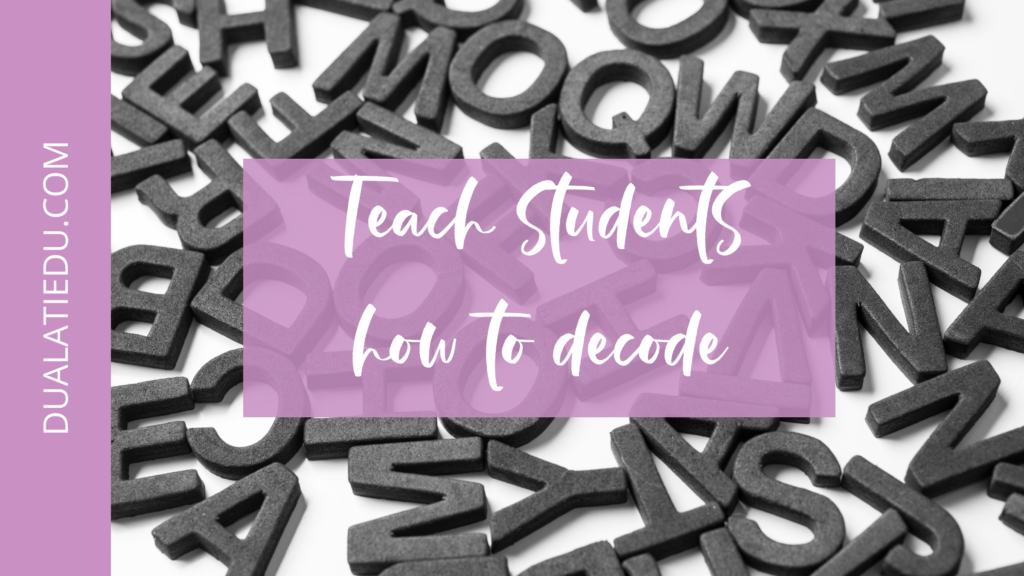
Teach English learners how to decode in English! It is the most obvious solution and yet the most difficult to implement. Why? Because this is not necessarily part of upper elementary grade-level standards. After 3rd grade, students are mainly reading to learn rather than learning to read. Spelling is still a vital part of the English Language Arts curriculum, but reading comprehension takes center stage after this grade. And, unfortunately, when standardized testing plays a significant role in deciding what to teach, it allows for the possibility to place this critical student need lower on the teacher’s to-do list.
So, how can teachers incorporate phonics instruction when it is not part of the grade level’s scope and sequence?
The teacher can make a yearly plan that defines when and where to systematically replace activities in the Language Arts block for direct phonics instruction targeted to the student’s language acquisition level.
Easier said than done, of course, but if we provide explicit training and appropriate grade-level resources, it will allow teachers to incorporate this naturally into their lessons actively.
So, what does this look like?
If you find a grade-appropriate research-based program, you can integrate it into your plans regardless of its intended use.
In the past, I have used dyslexia programs for phonics instruction for English learners. They are research-based, different versions are available for different grade levels, and provide a scope and sequence guide for teachers.
Planning steps for Phonics Instruction for English leaners
- Understand the need to deliver phonics instruction within the Language Arts curriculum
- Identify students who would benefit from phonics instruction
- Relay the need for phonics instruction to the student, the parent, and the campus literacy coach
- Administer a phonics screener at the beginning of the year (your basal usually brings one or have your literacy coach provide you one)
- Based on the results from the phonics screener, map out a scope and sequence for your targeted phonics instruction (if you have many ELs, look at results collectively)
- Select a time of the Language Arts block when students will be able to study phonics
- Choose the phonics instruction program you will use throughout the year and make sure to teach students how to use it independently
- Select what time during the Language Arts block and how often you will provide direct instruction
- Monitor progress by going back to parts of the phonics screener that have been addressed
- Celebrate progress
It may seem daunting, but if planned before school begins, it becomes part of your Language Arts block routine!
ESL Strategy #4 Targeted Vocabulary Instruction
We can’t list the 5 Best ESL Strategies without discussing vocabulary instruction.
Vocabulary development begins before a student enters kindergarten. A parent who reads to their child since birth provides them with a word bank of about a million words!
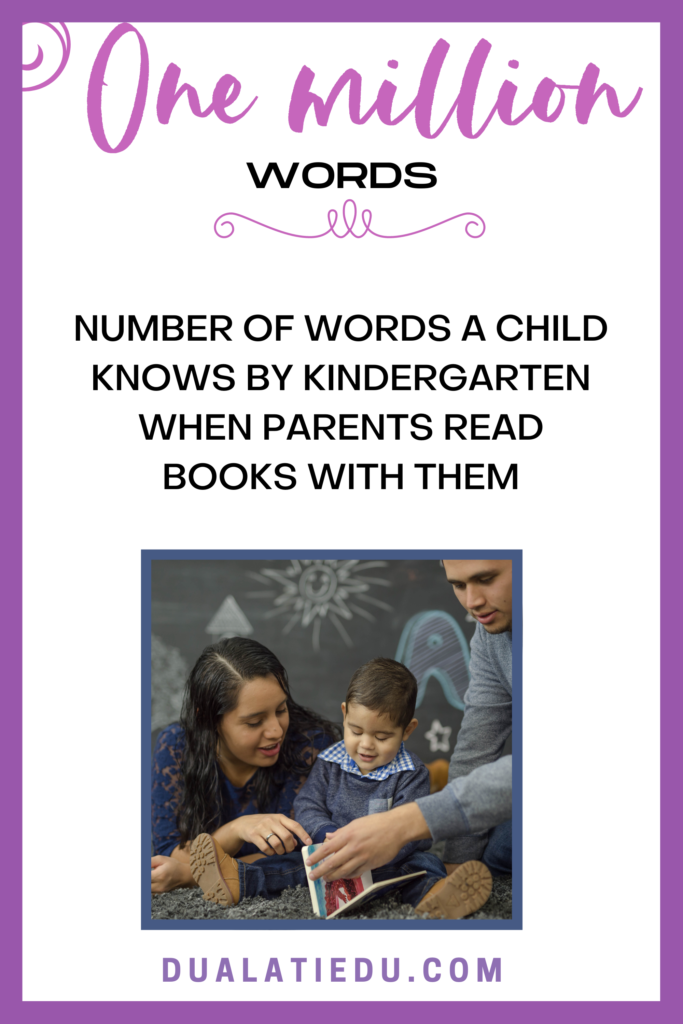
If a student struggles with reading comprehension, it may be due to a lack of vocabulary knowledge.
You can certainly see the relationship between vocabulary and reading comprehension with English learners.
Providing targeted vocabulary instruction is key to closing the gap between on-grade level and struggling students.
Tiers for Vocabulary Words
Words aren’t all the same when it comes to vocabulary development. You can categorize words into 3 tiers.
Tier 1 Vocabulary Words
These are common words used in everyday speech. Some examples are: ball, catch, run, eat, food
Upper elementary teachers do not incorporate these types of words into their curriculum, but English learners who just arrived in the US may need instruction on this type of word.
ESL teachers need to be aware how English learners may feel if given resources that may seem designed for lower grades. However, finding grade-level resources can be challenging. So, online vocabulary list generators may be an excellent option.
Tier 2 Vocabulary Words
Tier 2 words are high-frequency words from across different content areas or subjects. Some examples are: approach, exceed, commence
These words are crucial to reading comprehension. Since they appear more frequently in written text than everyday speech, it requires specific and direct instruction.
We have all seen that weekly list of vocabulary words in a basal book related to a particular story. Teachers provide direct instruction before reading the story, activities to complete during centers or homework, and an assessment at the end of the week.
The study of word parts is effective in teaching students how to understand new words by breaking them apart into smaller pieces with known meaning. Students should have a center that consistently teaches prefixes, suffixes and root words.
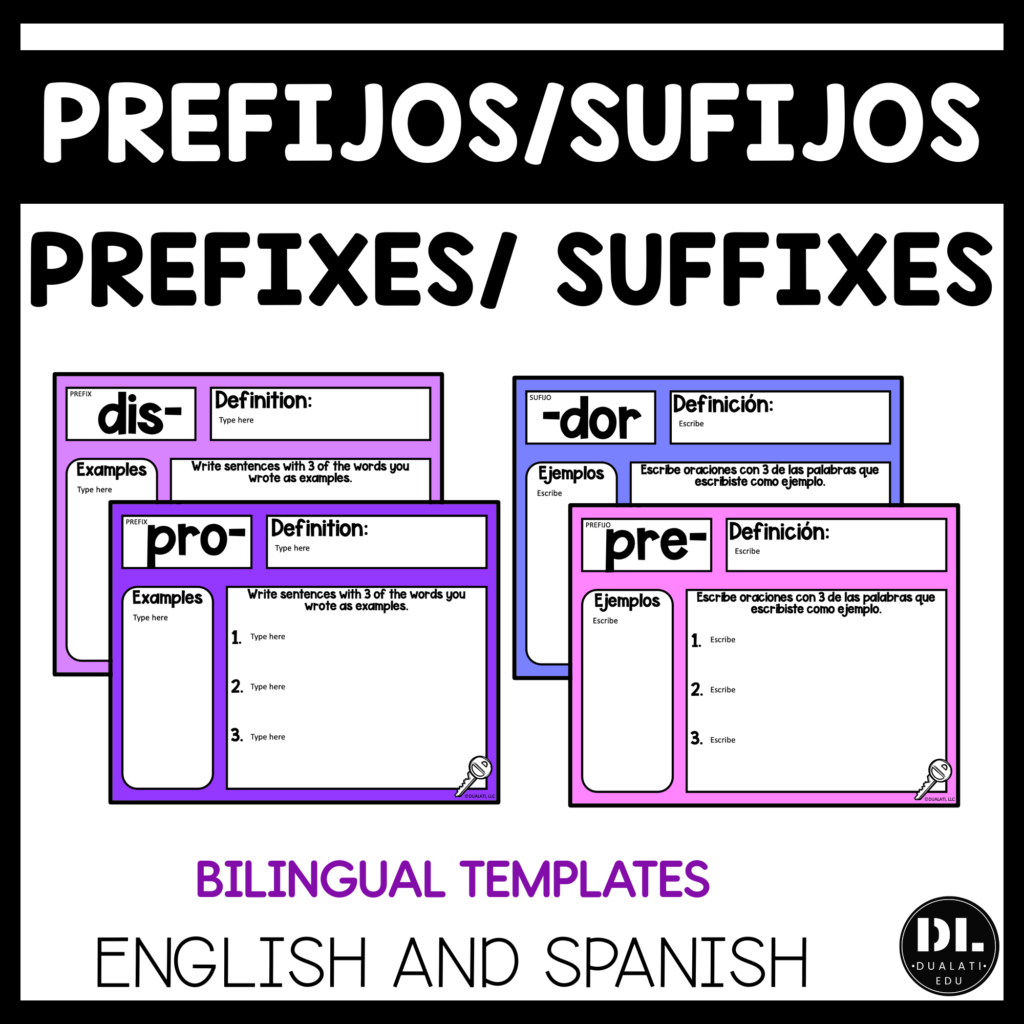
Tier 3 Vocabulary Words
Words that are not frequently used as they are specific to a particular subject. Some examples are: metamorphic, chlorophyll, denominator
The instruction for these words comes up naturally when teaching the content. Visuals are best since many are nouns.
In conclusion, for English learners direct instruction of Tier 1 words is as important as Tier 2 words. Design a system at the beginning of the year where students can master a routine for vocabulary development.
ESL Strategy #5 Bilingual Paired Texts
Finally, the last strategy I would like to address garners many different opinions.
It is allowing students to read the text in their native language alongside the English version.
Here are my thoughts. Paired texts can be ONE instrument of your ESL strategies toolbox. Ideally, you would have a carefully translated text in the student’s native language, but it is unlikely due to the wide variety of languages spoken in US schools.
Allowing for and even showing students how to use tools such as Google Translate™ in core areas such as Science, Math, or Social Studies provides the student the opportunity to learn the content and not feel left out of the education process.
The critical factor here is that they have BOTH texts available.
These are the 5 Best ESL strategies you can incorporate into your classroom. Yes, it will take some planning and effort beforehand. But, once planned out, they are easy to continue. You and your students will see the progress made and keep motivated to continue learning!
Learn more strategies by reading this blogpost on Effective Strategies for Teaching Language Learners.
SIDE NOTE: I have been wanting to share these ideas for a while and I am extremely thankful to those who have guided me in doing so. Check out how you can share your ideas through blogging here!
